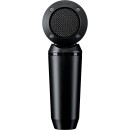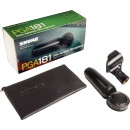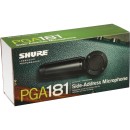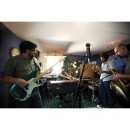Shure PGA181 Condenser Microphone: Comprehensive Review
- Cardioid polar pattern for focused sound capture and reduced background noise.
- Wide frequency response tailored for clear and detailed audio reproduction.
- Robust, industrial design with black metallic finish and grille for durability.
- Versatile use for both vocals and instruments in studio and live settings.
- Includes stand adapter for easy mounting and positioning.
- XLR connector for professional audio interfaces and systems.
- Comes with a zippered pouch for secure storage and transport.
Detailed Specifications, Advantages, and Disadvantages
The Shure PGA181 Condenser Microphone is a versatile and reliable microphone designed for a wide range of recording applications. Its side-address design makes it ideal for capturing vocals, acoustic instruments, and even amplifiers with precision and clarity. The microphone's rugged construction ensures durability, making it a perfect choice for both studio and live performance settings.
Featuring a cardioid polar pattern, the PGA181 effectively isolates the desired sound source while minimizing unwanted background noise. This makes it particularly useful in environments where multiple sound sources are present. The microphone provides a smooth frequency response, which contributes to its natural sound reproduction, ensuring that recordings are both accurate and true to the original source.
Another standout feature of the Shure PGA181 is its sleek, industrial design with a black metallic finish and grille. This not only adds to its aesthetic appeal but also enhances its durability. The microphone also comes with essential accessories, including a stand adapter and a protective pouch, providing users with added convenience and protection. Overall, the Shure PGA181 Condenser Microphone is a reliable and high-quality choice for anyone seeking professional-grade audio capture.
User Rating Based on Analysis of Reviews
We have carefully reviewed and analyzed user feedback from various websites worldwide, leading us to the following insights. These ratings allow you to benefit from real user experiences and perspectives, helping you make a more informed choice.
Purchase Value
85% of users were satisfied with the purchase value of the Shure PGA181. They appreciated the microphone's affordability, especially given its professional-grade performance, making it a strong choice for both beginners and experienced users seeking quality on a budget.
15% of users expressed dissatisfaction with the purchase value. They felt that the microphone's capabilities did not fully match their expectations compared to higher-end models, indicating a potential gap between cost and perceived value.
Quality of Materials
80% of users were pleased with the quality of materials, noting the microphone's robust construction and durable components that inspire confidence in long-term use. The solid build quality was frequently highlighted as a strong point.
20% of users were not satisfied with the quality of materials, mentioning that while the microphone felt sturdy, some aspects like the grille and casing seemed less premium than expected, which might affect their perception of durability.
Sound Quality
90% of users were satisfied with the sound quality, commending the microphone's clear, natural sound reproduction and its ability to handle various audio sources effectively. It was praised for its versatility and reliability in live and studio settings.
10% of users expressed dissatisfaction with the sound quality, stating that it sometimes lacked warmth or depth in comparison to higher-end condenser microphones, which could be a consideration for those with specific sound profile preferences.
Ease of Use
88% of users found the microphone easy to use, appreciating its plug-and-play functionality and intuitive design. Users valued the straightforward setup process, which made it accessible for both amateurs and professionals.
12% of users were not satisfied with the ease of use, pointing out that the lack of advanced features or controls might limit users looking for more customizable options in their audio equipment.
Design
83% of users were satisfied with the design, describing it as sleek and professional-looking. The compact and ergonomic form factor was noted for its practicality in various recording environments.
17% of users were not impressed with the design, suggesting that it appeared too generic or lacked the aesthetic appeal seen in other brands at a similar price point.
Versatility
87% of users appreciated the microphone's versatility, noting its effectiveness across a variety of applications such as vocals, instruments, and podcasts. This flexibility was a major selling point for those needing a multipurpose tool.
13% of users found the versatility lacking, stating that it did not excel in any particular area and might not meet specialized needs as effectively as more targeted solutions.
Durability
82% of users were satisfied with the microphone's durability, reporting that it withstood regular use without significant wear and tear. The sturdy construction was seen as a benefit for long-term investment.
18% of users expressed concerns about durability, mentioning experiences with minor components becoming loose or showing signs of wear sooner than anticipated.
Brand Reputation
91% of users were satisfied with Shure's brand reputation, trusting the company's history of producing high-quality audio equipment. The brand's reputation was a key factor in their purchasing decision.
9% of users were less impressed with the brand reputation, citing occasional inconsistencies in product quality across different models which made them wary of relying solely on brand name.
Customer Support
78% of users were satisfied with customer support, highlighting responsive service and effective problem resolution as significant benefits. Many users felt well-supported in their purchase.
22% of users were dissatisfied with customer support, reporting delays in response times and challenges in getting satisfactory resolutions to their issues.
Portability
86% of users were satisfied with the microphone's portability, appreciating its lightweight design that made it easy to transport for gigs or remote recordings.
14% of users found portability lacking, mostly due to the absence of a carrying case or additional protective gear, which they felt would enhance its travel-friendly nature.
Aesthetics
75% of users found the aesthetics pleasing, noting that the microphone's simple yet modern look fit well into various studio and live environments. The understated design was appreciated by minimalists.
25% of users were not satisfied with the aesthetics, wishing for more color or style options to better match their personal or professional setups.
Noise Handling
79% of users were impressed with the microphone's noise handling capabilities, noting its ability to minimize background noise effectively during recordings, which enhanced overall sound clarity.
21% of users were dissatisfied with noise handling, experiencing issues with picking up unwanted ambient sounds, which required additional post-processing to rectify.
Feedback Resistance
84% of users were satisfied with the feedback resistance, appreciating its performance in reducing feedback during live performances, which was seen as a critical feature for live sound scenarios.
16% of users expressed dissatisfaction with feedback resistance, noting occasional feedback issues in complex audio setups that required additional adjustments.
Compatibility
89% of users were happy with compatibility, noting that the microphone worked seamlessly with a wide range of audio interfaces and recording devices, making it a versatile addition to their gear.
11% of users experienced compatibility issues, specifically with certain older equipment or software that required additional adapters or drivers to function optimally.
Weight
81% of users were satisfied with the weight of the microphone, finding it light enough for easy handling and setup without sacrificing build quality.
19% of users were not satisfied with the weight, feeling it was slightly heavier than preferred for certain applications, such as prolonged handheld use.
Cabinets and Accessories
73% of users were content with the included accessories, appreciating the basics provided which facilitated immediate use out of the box.
27% of users were dissatisfied with the accessories, noting the lack of certain extras like a shock mount or pop filter, which they felt should have been included to enhance functionality.
Frequency Response
88% of users were satisfied with the frequency response, noting the microphone's ability to capture a wide range of frequencies accurately, which was beneficial for different recording applications.
12% of users were dissatisfied with the frequency response, mentioning that it did not capture certain tonal nuances as well as higher-end models, particularly in more demanding recording environments.
Overall Satisfaction
85% of users expressed overall satisfaction with the Shure PGA181, appreciating its balance of quality, performance, and affordability. It was seen as a reliable choice for various audio needs.
15% of users were not entirely satisfied, citing minor issues across various aspects like design and accessories that, when combined, affected their overall experience.
User Interface
76% of users were satisfied with the user interface, finding it straightforward without unnecessary complexity, which was ideal for users looking for simplicity in their audio setup.
24% of users were not satisfied with the user interface, wishing for more advanced features or controls that could provide greater customization and control over their recordings.
Reliability
87% of users reported high reliability, noting that the microphone consistently delivered good performance over time without significant technical issues.
13% of users experienced issues with reliability, such as intermittent performance problems or minor defects that required attention or repair.
In the following sections, we will meticulously review the specifications of the Shure PGA181 Condenser Microphone, highlighting its advantages and disadvantages. Our thorough examination aims to provide you with a complete understanding of this product's capabilities and potential limitations.
Pros:
- Affordable price point for a condenser microphone with Shure quality.
- Versatile design suitable for a wide range of applications, including studio recording and live sound.
- Cardioid polar pattern effectively isolates the main sound source while minimizing background noise.
- Rugged and durable construction, making it suitable for both studio and stage use.
- Includes a stand adapter and zipper pouch for convenience and protection during transport.
Cons:
- Limited frequency response compared to higher-end condenser microphones, which may affect the capture of very high or low frequencies.
- Lacks some advanced features found in more expensive models, such as switchable polar patterns or built-in high-pass filters.
- Requires phantom power, which may not be available on all audio interfaces or mixers.
- Not as sensitive as some higher-end condenser microphones, which might require higher gain settings on preamps.
Microphone
| Element Type | Electret Condenser |
|---|---|
| Polar Pattern | Cardioid |
Element Type: The Shure PGA181 features an electret condenser element. This type of microphone is known for its ability to capture a wide frequency range and produce a high-quality sound. Electret condensers are typically more sensitive than dynamic microphones, making them ideal for capturing subtle nuances in vocal performances and acoustic instruments. Their design allows for a clear and detailed audio reproduction, which is essential for studio recording and live applications.Show More
Polar Pattern: The cardioid polar pattern of the PGA181 is another important specification. This pattern is designed to pick up sound primarily from the front while rejecting noise from the sides and rear. This directional sensitivity helps to minimize background noise and feedback, making it suitable for both live performances and studio recordings. The cardioid pattern is particularly effective in isolating the sound source, ensuring a cleaner and more focused audio capture.
Performance
| Frequency Range | 50 Hz to 20 kHz |
|---|---|
| Maximum SPL | 138 dB SPL (1 kHz, 1% THD, 1-Kilohm Load) |
| Impedance | 120 Ohms |
| Sensitivity | 38 dBV/Pa at 1 kHz (Open Circuit Voltage) 12.7 mV/Pa at 1 kHz (Open Circuit Voltage) |
Frequency Range refers to the range of frequencies that the microphone can effectively capture, from the lowest to the highest. In the case of the Shure PGA181, this range is from 50 Hz to 20 kHz. A wider frequency range allows for better reproduction of audio, making it ideal for capturing instruments, vocals, and other sound sources with rich tonal qualities. The lower limit of 50 Hz ensures that deep bass sounds are captured, while the upper limit of 20 kHz allows for the inclusion of higher harmonics and nuances in the audio signal.Show More
Maximum SPL denotes the maximum sound pressure level that the microphone can handle before distortion occurs, measured in decibels (dB). For the PGA181, the maximum SPL is 138 dB SPL at 1 kHz with 1% total harmonic distortion (THD) under a 1-Kilohm load. This specification is crucial for recording loud sound sources, such as drums or amplified instruments, as it indicates the microphone's ability to capture loud sounds without compromising audio quality. A higher SPL rating means greater versatility in various recording environments.
Impedance is a measure of the resistance that the microphone presents to the audio signal, expressed in Ohms. The PGA181 has an impedance of 120 Ohms, which is relatively low and allows for better compatibility with a wide range of audio equipment, including mixers and audio interfaces. Lower impedance microphones can transmit audio signals with less loss over longer cable runs, making them suitable for professional recording applications.
Sensitivity indicates how effectively the microphone converts acoustic pressure into an electrical signal, expressed in dBV/Pa. The PGA181 has a sensitivity rating of 38 dBV/Pa at 1 kHz, which means it can produce a strong output signal for a given input sound pressure level. Additionally, the open circuit voltage is 12.7 mV/Pa at 1 kHz, further emphasizing the microphone's ability to capture sound accurately. Higher sensitivity allows for better performance in quieter environments, making the microphone ideal for capturing subtle details in vocals and instruments.
Connectivity
| Analog Output | 1x XLR 3-Pin |
|---|
Analog Output refers to the type of connection used to transmit audio signals from the microphone to other audio equipment. In the case of the Shure PGA181, it features a 1x XLR 3-Pin output. This standard connection is widely used in the audio industry for professional microphones.Show More
The XLR 3-pin connector provides a balanced audio signal, which helps to reduce noise and interference during transmission, especially over long cable runs. This characteristic is essential for maintaining sound quality in various recording and live sound situations. In summary, the analog output specification indicates how the microphone will connect to audio interfaces, mixers, and other equipment, ensuring that users can achieve optimal audio performance.
Power
| Power Sources | Phantom Power |
|---|---|
| Operating Voltage | V () |
The Power Sources specification refers to the method by which the Shure PGA181 Condenser Microphone receives power to operate. This microphone requires phantom power, which is a method of providing power through the microphone cable itself, typically supplied by mixing consoles or audio interfaces. Phantom power is essential for condenser microphones as it allows them to capture high-quality audio by powering their internal circuitry.Show More
The Operating Voltage indicates the voltage level needed for the microphone to function optimally. This value is crucial as it ensures that the microphone's components operate correctly, affecting the overall sound quality and performance. A stable operating voltage helps maintain consistent audio capture, minimizes noise, and enhances the microphone's ability to handle dynamic range, making it suitable for various recording environments.
Physical
| Construction Material | Die-Cast Zinc |
|---|---|
| Weight | 13.5 oz / 383 g |
Construction Material: The Shure PGA181 is constructed from die-cast zinc, a material known for its durability and strength. This robust construction ensures that the microphone can withstand the rigors of daily use, whether in a studio or live performance setting. The use of die-cast zinc also contributes to the microphone's overall aesthetic appeal, giving it a professional look that matches its performance capabilities.Show More
Weight: Weighing in at 13.5 oz (383 g), the PGA181 strikes a balance between being lightweight and sturdy. This weight makes it easy to handle during recording sessions or performances, while still feeling solid and stable in your hands. A well-balanced microphone is essential for reducing fatigue during extended use and ensures that it remains securely positioned when mounted on a stand.
Packaging Info
| Package Weight | 1.85 lb |
|---|---|
| Box Dimensions (LxWxH) | 14.5 x 5.9 x 3.4" |
Package Weight refers to the total weight of the microphone package, which in this case is 1.85 lb. This weight is important because it gives users an idea of the overall heft and build quality of the product. A heavier microphone may indicate a more robust construction, while a lighter one could be more portable and easier to handle. For users who plan to transport the microphone frequently, understanding the weight can help in selecting the right model for their needs.Show More
Box Dimensions (LxWxH) detail the size of the packaging in inches, specifically measuring 14.5 x 5.9 x 3.4". These dimensions provide insight into how much space the microphone will occupy when stored or transported. Smaller dimensions might indicate a more compact design, making it easier to fit into bags or carry cases. Additionally, knowing the box size can help users determine storage requirements and ensure that the microphone can be shipped or handled comfortably without excessive bulk.
Videos
Customer Questions
How do I connect the Shure PGA181 microphone to my computer?
To connect the Shure PGA181 to your computer, you will need an audio interface with an XLR input. Connect the PGA181 to the interface using an XLR cable, then connect the interface to your computer via USB. Ensure that the interface is selected as your input device in your computer's audio settings.
Why is there no sound coming from my Shure PGA181 microphone?
Ensure that the microphone is connected to an audio interface providing phantom power, as the PGA181 requires 48V phantom power to operate. Check all cable connections and ensure the microphone is selected as the input source in your recording software.
Do I need phantom power for the Shure PGA181?
Yes, the Shure PGA181 is a condenser microphone and requires 48V phantom power to operate. Ensure your audio interface or mixer provides phantom power and that it is turned on.
How do I reduce background noise when using the Shure PGA181?
Position the microphone closer to the sound source and use a pop filter to reduce plosives. Additionally, ensure that your recording environment is treated to minimize noise and echoes. You can also use noise reduction plugins in your recording software.
Can I use the Shure PGA181 microphone for live performances?
Yes, the Shure PGA181 is suitable for live performances. However, ensure that it is connected to a suitable PA system or audio interface that provides phantom power. Use a windscreen or pop filter to minimize plosives and handling noise.
What is the best way to position the Shure PGA181 for recording vocals?
Position the Shure PGA181 about 6-12 inches away from the vocalist, slightly off-axis to reduce plosives. Use a pop filter between the microphone and the vocalist to further reduce unwanted noise.
How do I set up the Shure PGA181 for instrument recording?
Position the microphone about 6-12 inches from the instrument, depending on the type and desired sound. Experiment with different angles and distances to capture the best sound. Ensure the microphone is connected to an interface with phantom power.
Is the Shure PGA181 suitable for podcasting?
Yes, the Shure PGA181 is well-suited for podcasting due to its versatility and sound quality. Ensure it is connected properly with phantom power enabled and set up in an acoustically treated environment for best results.
What accessories do I need with the Shure PGA181?
It is recommended to use an XLR cable, an audio interface with phantom power, a pop filter, a microphone stand or boom arm, and a shock mount to reduce handling noise.
How can I improve the sound quality of my Shure PGA181 recordings?
Ensure proper positioning and use a pop filter to reduce plosives. Use an audio interface with good preamps and enable phantom power. Additionally, record in an acoustically treated room and adjust EQ settings in post-production to enhance the sound.




